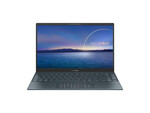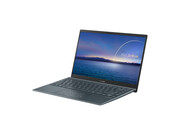Asus ZenBook 13 UX325EA, i7-1165G7
Specifiche tecniche

Price comparison
Media dei 5 punteggi (dalle 8 recensioni)
recensioni per Asus ZenBook 13 UX325EA, i7-1165G7
Sorgente: Pokde
 EN→IT Archive.org version
EN→IT Archive.org versionAll in all, I think that the ASUS ZenBook 13 OLED (UX325) is a pretty good laptop that’s fit for both work and play. It has a very aesthetically pleasing design, an absolute beauty of an OLED screen, solid build quality, exceptional speaker performance, fantastic battery life, bundled Microsoft Office and while it performs decently when gaming though it is clear this laptop is not made for hardcore gaming. There are some niggling issues though such as the stiff keyboard keys, inconsistent trackpad sensitivity, lack of a 3.5mm headphone jack and problems with the included Type-C to 3.5mm adapter. At the end of the day, the positives of the ASUS ZenBook 13 OLED (UX325) far outweigh the negatives and would be a very good choice for those looking for a capable work laptop that suits both home and office, especially if you appreciate a good display with vibrant, accurate colours and true, deep blacks.
Singola recensione, disponibile online, Lungo, Data: 07/23/2021
Valutazione: Punteggio totale: 83% prezzo: 80% prestazioni: 83% mobilità: 86% qualità di lavorazione: 86%
Sorgente: Unbox
 EN→IT Archive.org version
EN→IT Archive.org versionThe ZenBook 13 UX325EA has all the hallmarks of a good, premium laptop along with the performance to back it up. Intel’s 11th gen processors give it a much needed graphical boost, and better battery endurance will come in handy once we’re all allowed to safely go out again.
Singola recensione, disponibile online, Lungo, Data: 12/06/2020
Sorgente: Ultrabook Review
 EN→IT Archive.org version
EN→IT Archive.org versionWhile I can't draw final conclusions on the ZenBook S UX393 based on this early sample alone, I can tell you that this is one of the most complete ultrabooks on the market right now: it's very well crafted, offers an excellent wide-gamut touchscreen, doesn't compromise much on the IO and is a competent Tiger Lake implementation, backed up by a big battery. However, I need to further clarify our findings in the typing and efficiency sections before wrapping this up. We'll get in-depth on all these aspects down below.
Singola recensione, disponibile online, Lunghissimo, Data: 10/07/2020
Valutazione: Punteggio totale: 85%
Sorgente: Laptop Mag
 EN→IT Archive.org version
EN→IT Archive.org versionThe Asus ZenBook 13 UX325EA straddles the line between business and premium. For $999, you get a system rocking the fetching good looks of the company’s top-tier laptops with some of the durability and security features of the ExpertBook, the company’s new business line. Plus, you get the added muscle of Intel’s new 11th Gen chips and all the features Intel’s Evo initiative brings, including over 13 hours of battery life. And you can even game in a pinch (just not at the highest settings).
Singola recensione, disponibile online, Lunghissimo, Data: 09/30/2020
Valutazione: Punteggio totale: 90%
Sorgente: MuyComputer
 ES→IT Archive.org version
ES→IT Archive.org versionSingola recensione, disponibile online, Lungo, Data: 08/03/2021
Valutazione: Punteggio totale: 91% prezzo: 95% prestazioni: 95% mobilità: 80% qualità di lavorazione: 90%
Sorgente: Mi Mundo Gadget
 ES→IT Archive.org version
ES→IT Archive.org versionSingola recensione, disponibile online, Medio, Data: 07/26/2021
Sorgente: Frandroid
 FR→IT Archive.org version
FR→IT Archive.org versionSingola recensione, disponibile online, Lunghissimo, Data: 03/01/2021
Valutazione: Punteggio totale: 80%
Sorgente: Nghenhin Vietnam
 VN→IT Archive.org version
VN→IT Archive.org versionConfronto, disponibile online, Medio, Data: 11/17/2020
Commenti
Intel Iris Xe G7 96EUs:
Scheda grafica integrata nei SoC Intel Tiger Lake G4 basati sulla nuova architettura Gen. 12 con 96 EU (Execution Units / Shader Cluster). La frequenza di clock dipende dal modello di processore. I chip Tiger Lake sono prodotti nel moderno processo 10nm+ di Intel.
Ridurre la distanza delle Schede Grafiche per gli utenti che vogliono utilizzare il videogiochi. I nuovi giochi dovrebbero funzionare su queste schede, ma con riduzione dei dettagli e risoluzione mediocre.
>> Ulteriori informazioni le potete trovare nel nostroConfronto delle schede grafiche e nella nostra Lista dei Benchmark.
i7-1165G7:
Processore quad-core a bassa potenza basato su Tiger Lake per computer portatili sottili e leggeri. I quattro cores si aggirano intorno ai 2,8 - 4,7 GHz. Prodotto in 10nm+ alla Intel.
>>Ulteriori informazioni le potete trovare nel nostroConfronto dei processori per portatili.




